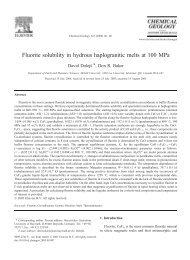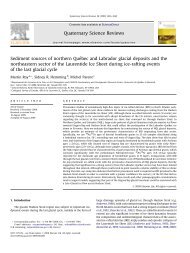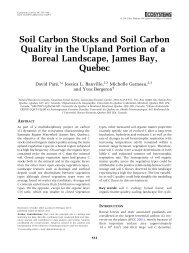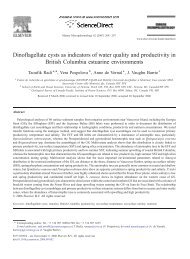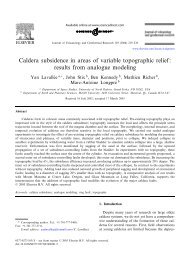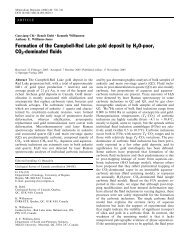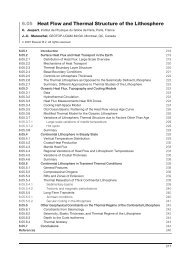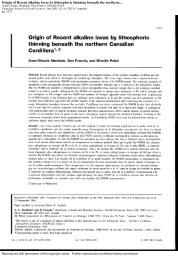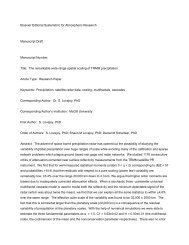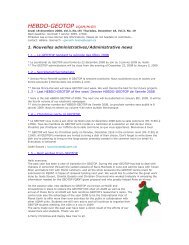A pervasive link between Antarctic ice core and subarctic Pacific ...
A pervasive link between Antarctic ice core and subarctic Pacific ...
A pervasive link between Antarctic ice core and subarctic Pacific ...
Create successful ePaper yourself
Turn your PDF publications into a flip-book with our unique Google optimized e-Paper software.
S.L. Jaccard et al. / Quaternary Science Reviews 29 (2010) 206–212 209<br />
amplitude (Fig. 3) of the signal. Ba/Al <strong>and</strong>, to a lesser degree, Ca/Al<br />
show a generally lower amplitude <strong>between</strong> 450 <strong>and</strong> 750 kyrs<br />
during the ‘‘luke-warm’’ interglacials, MIS 13, 15 & 17 (Figs. 3 <strong>and</strong> 4).<br />
In particular, interglacial maxima show significantly lower values<br />
when compared to the past 450 kyr, the glacial baseline remaining<br />
rather constant across the entire record (Fig. 2). We note, however,<br />
that the correlation <strong>between</strong> ODP882 Ba/Al <strong>and</strong> EDC dD <strong>and</strong> CO2<br />
was markedly weaker prior to 450kyr, for reasons that are currently<br />
unclear. Further investigations will aim to clarify this issue.<br />
4. Discussion<br />
Reconstruction of past changes in organic carbon export is<br />
uncertain, as each proxy has its own biases. Here we analyze two<br />
different proxies, both of which yield a picture that is internally<br />
consistent <strong>and</strong> supported by data from the literature (see above). It<br />
is important to point out that the concentrations of both organic<br />
carbon <strong>and</strong> chlorins (an algal biomarker) are higher in glacial age<br />
sediments, in contrast to the bioBa <strong>and</strong> opal (Gebhardt et al., 2008;<br />
Gorbarenko, 1996; Haug et al., 1995; Kiefer et al., 2001; Shigemitsu<br />
et al., 2007). These organic phases might seem to be more direct<br />
proxies of carbon export than the mineral proxies we present here.<br />
However, the maximum chlorin concentrations observed in <strong>core</strong><br />
MD01-2416 (Gebhardt et al., 2008), gradually decrease down<strong>core</strong><br />
with values up to 10 000 ng/g for TERM I to 20 mM)<br />
(Pedersen <strong>and</strong> Ingram, 1995). We therefore assume here that the<br />
less direct, but hopefully more robust mineral proxies are the most<br />
accurate reflection of past changes in export production, with the<br />
caveat that the causes of higher glacial concentrations of organic<br />
components should be more thoroughly investigated.<br />
Shigemitsu et al. (2007) recently presented a novel approach to<br />
address past changes in the dust flux to the western <strong>subarctic</strong><br />
<strong>Pacific</strong>. Their results show that the eolain contribution to the<br />
sediment was approximately tw<strong>ice</strong> as high during the past <strong>ice</strong> ages<br />
when compared to interglacials. Preliminary results, based on 232 Th<br />
MAR (Jaccard et al., 2009) seem to support their conclusion. As<br />
a result, a portion of the Ba/Al signal is likely to reflect the enhanced<br />
input of eolian material during glacial intervals. However, 230Thnormalized<br />
flux reconstructions for TERM I (Jaccard et al., 2009)<br />
clearly confirm that the last deglaciation was marked by a large<br />
increase in the preserved flux of biogenic detritus, accompanying<br />
the inferred decrease in dust supply.<br />
Reconstructions of sea surface temperature from alkenones<br />
(Haug, 1996), foraminiferal Mg/Ca (Gebhardt et al., 2008), <strong>and</strong><br />
foraminiferal transfer functions (Kiefer et al., 2001; Kiefer <strong>and</strong><br />
Kienast, 2005) all indicate that, even during the coldest times,<br />
summertime SST never approached freezing in the vicinity of the<br />
<strong>core</strong> site. This corroborates micropaleontological evidence that ODP<br />
Site 882 is located well east of the maximum perennial sea-<strong>ice</strong><br />
extent over the Pleistocene (Climap Members, 1981) (Sancetta <strong>and</strong><br />
Silvestri, 1986). As a result, sea <strong>ice</strong> cover is unlikely to have represented<br />
a major limitation on the spring/summer growing season<br />
during glacial times. Rather, some other factor must have limited<br />
phytoplankton growth during glacial times. The aeolian dust supply<br />
(cps)<br />
Ba/Al<br />
D‰ ( vsSMOW )<br />
δ<br />
5.5<br />
5.0<br />
4.5<br />
4.0<br />
3.5<br />
3.0<br />
2.5<br />
2.0<br />
1.5<br />
-360<br />
-380<br />
-400<br />
-420<br />
-440<br />
T V<br />
T IV<br />
T VIII<br />
T VII<br />
TI T T III<br />
T IX<br />
II<br />
T VI<br />
b<br />
d<br />
a<br />
c<br />
200<br />
150<br />
100<br />
50<br />
0<br />
300<br />
280<br />
260<br />
240<br />
220<br />
200<br />
180<br />
160<br />
Ca/Al (cps)<br />
C O (ppmv )<br />
2<br />
-460<br />
0 100 200 300 400 500 600 700 800<br />
Age (kyr)<br />
Fig. 2. (a) Ca/Al <strong>and</strong> (b) Ba/Al records from ODP site 882 compared to (c) EDC CO 2 (Lüthi et al., 2008) (Monnin et al., 2001) (Siegenthaler et al., 2005) <strong>and</strong> (d) the deuterium (dD)<br />
(Jouzel et al., 2007) records during the past 800 kyrs. Glacial Terminations are indicated using Roman numerals in subscript.



